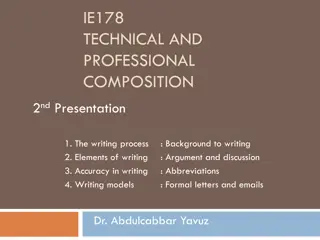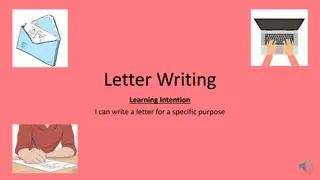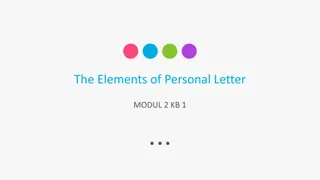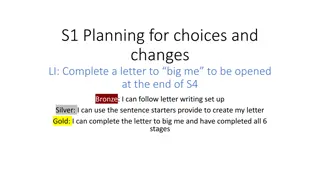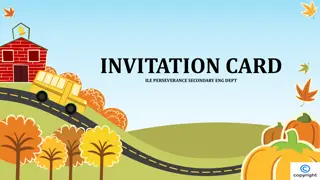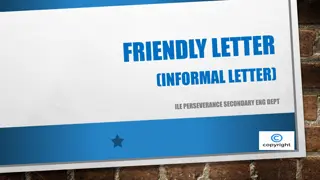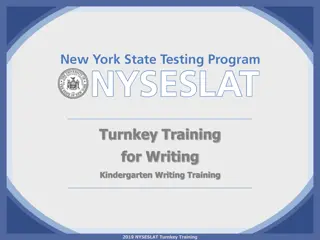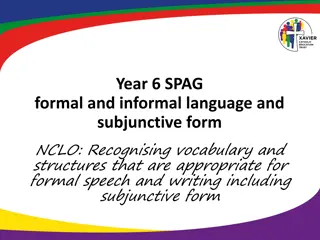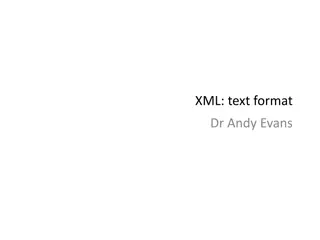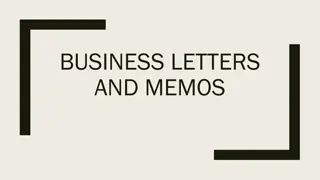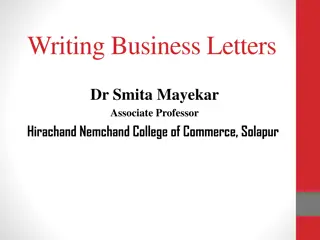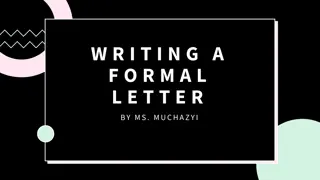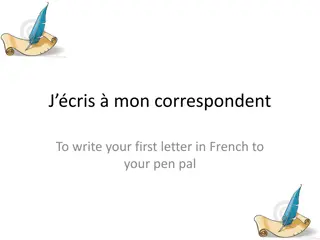Formal Letter Writing: Types, Details, and Formats
The formal letter is a powerful communication tool for various purposes such as addressing authorities, job offers, complaints, and more. Learn about the types of formal letters, essential writing details like addressing, salutation, subject, and body paragraphs. Emphasize clarity, professionalism, and correct formatting in your formal letter writing practice.
Download Presentation

Please find below an Image/Link to download the presentation.
The content on the website is provided AS IS for your information and personal use only. It may not be sold, licensed, or shared on other websites without obtaining consent from the author.If you encounter any issues during the download, it is possible that the publisher has removed the file from their server.
You are allowed to download the files provided on this website for personal or commercial use, subject to the condition that they are used lawfully. All files are the property of their respective owners.
The content on the website is provided AS IS for your information and personal use only. It may not be sold, licensed, or shared on other websites without obtaining consent from the author.
E N D
Presentation Transcript
What Is A Formal Letter? Formal Letter Meaning: A formal letter is one that uses formal language and is written in a formal style. Such letters are not addressed to private individuals, such as friends or family members, authorities, dignitaries, coworkers, and seniors for official objectives. Writing formal letters requires adherence to a variety of conventions. but rather to 2/10 Nithya Prakash /FACULTY/English/SNSACD
Types Of Formal Letter The formal letter comes in a variety of forms and is utilized as a communication tool by all organizations, whether they are public or private. Both internal and external communication uses formal letters. Here are some examples of formal letter formats. Recovery Letter Resignation Letter Order Letter Promotion Letter Job offer letter Complaint letter Business letter Appointment letter Leave application for Marriage/ Sick/ maternity Letter of Enquiry Sales Letter 3/10 Nithya Prakash /FACULTY/English/SNSACD
Details Of Formal Letter Writing Format 1) Address The sender's and recipient's addresses are the first item in the formal letter format. Sender's Address: Be sure to include your street address, city, state, zip code, and phone number when writing your address in the left-hand corner of the page. Address of Recipient Always include the address of the recipient in the right-hand corner, just below the date. 2) Date The date and salutation are the second essential component of a professional letter format. The date should always be written with a line gap just below the sender's address. 4/10 Nithya Prakash /FACULTY/English/SNSACD
3) Salutation "Dear Sir/Madam" is sufficient; if you know the person's name, address them directly. If you don't know their name, use "Rev.", "Dr.", "Mr.", "Mrs.", or "Ms." in a formal manner, along with their complete name. 4) Subject The official letter comes next. The letter's subject and body are its format: The agenda or purpose of the letter's drafting is its subject. Keep the letter's subject short and, if you can, limit it to one line. 5
5) Body Always break up your work into paragraphs, and make sure to use a sophisticated vocabulary as well as correct punctuation and spelling. To keep the reader engaged and to distinguish one idea from another, paragraphs are used. The goal is to provide the reader with as much clarity as possible. Mention the goal of the letter in the first paragraph itself so that the reader is clear on your intentions when writing the letter. The first paragraph, also known as the introduction, should be brief and to the point. The middle paragraphs, generally known as the body of the letter, should include some relevant information on the goal outlined in the first paragraph. The final paragraph, sometimes referred to as the conclusion, should discuss the action you expect the letter's reader to take. As much as you can, keep the final paragraph in a requesting mode. Nithya Prakash /FACULTY/English/SNSACD 6
6) Conclusion The ending, or how to end the formal letter, is another element of the formal letter format. Putting a formal letter to bed - The preferred concluding salutations are Yours Faithfully, Your Sincerely, etc., followed by your entire name and a suitable closing sentence. An appropriate closing statement shows that you value the receiver by expressing your admiration for them. 7) Signature The signature at the end of the formal letter is the final component of the format. In the signature line of a formal letter, the sender should include their name, signature, and, if applicable, their position within the employer. Recognizing the information sent by the sender aids the recipient. 7/10 Nithya Prakash /FACULTY/English/SNSACD
The Headmistress MMMM Girls High School Chennai 110096 25thSeptember, 2023 Subject: Seeking permission to attend a family function How To Write A Formal Letter To Principal? Have a look at the examples of formal letters provided below for your reference. Formal Letter To Principal From Student 1 Respected Ma am, I am writing to seek your permission for me to attend a family function on the 29thof September at Bangalore. I would require a leave of three days (from 29.9.2023 to 1.10.2023). I have taken permission from my Class Teacher, and I will ensure that I keep myself informed about the daily lessons and complete everything up-to- date when I am back. Kindly consider my request and grant me permission. Thanking you Yours sincerely, Sara Class X A Roll No. 45 8/10 Nithya Prakash /FACULTY/English/SNSACD
The Principal BBBB Public School Salem. 29/09/2023 Subject: Requesting one week s leave Formal Letter To Principal From Student 2 Respected Ma am, This is to inform you that my mother is seriously ill and I am required to stay with her as there is no one else to take care of her. She is required to be taken to the hospital every now and then and needs constant support as doctors have advised complete bed rest. So, I request you to kindly allow me a week s leave, starting today, 29/09/2023 to 5/10/2023. My friends have assured me to bring every day s notes, and I will submit all my work through them. My Class Teacher is also very supportive. She has promised to send me audio recordings of classes so that I would not miss out on anything during this period. With everyone s support, I am sure I can get through this difficult phase. Thank you in advance for your kind understanding. Yours faithfully, Sherlin Student of Class XI A Roll No. 34 9/10 Nithya Prakash /FACULTY/English/SNSACD
Do's: Formal Letter Writing Format Make your letter's goal clear; it should be straightforward and focused. Your letter should be left-justified. In your letter, a single space and a space between each paragraph are required. Examples of plain typefaces are Arial, Times New Roman, Courier New, and Verdana. The font size ought to be 10 or 12. Leave a blank line between the salutation and the closing. Business letters should always be produced on white bond paper as opposed to colorful paper or personal stationery. If you're writing an email letter, follow these instructions for what to include and how to format your signature. After you've finished writing your letter, always proofread it for spelling and grammar mistakes. Nithya Prakash /FACULTY/English/SNSACD 10/10
Don't's: Formal Letter Writing Format Here are the common mistakes in formal letter writing that should be avoided. Make sure to adhere to the right formal letter format. This comprises a suitable headline, salutation, body, conclusion, and signature. Make sure the goal of your communication is stated in full. Be specific in what you want to say or what you are asking for. Check your letter carefully for any spelling or grammar mistakes before sending it. Use the appropriate punctuation and capitalization. Avoid employing slang or informal language in formal correspondence. Be respectful and professional in your tone. Double-check that the recipient of your letter has the correct name and address. This will guarantee that your mail gets to the correct person. Keep your letter brief and crisp. Don't blather on or provide unnecessary details. Make sure your letter is understandable and clear. Avoid using technical phrases unless absolutely required and speak plainly. If you expect a response to your letter, make sure to follow up if you don't get one in a timely manner. You may write a formal letter that is both effective and professional by keeping these most common errors to a minimum. 11/10 Nithya Prakash /FACULTY/English/SNSACD




